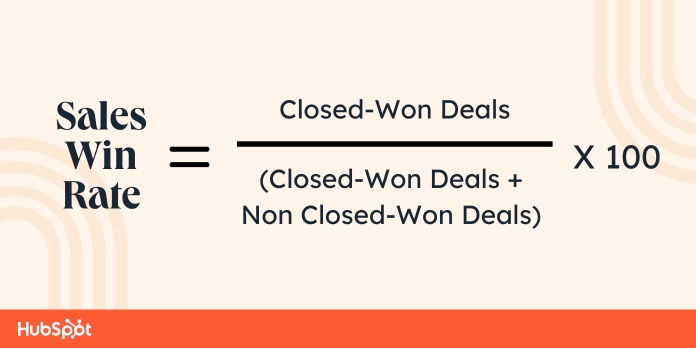Companies use win rate to determine which time periods, sales reps, and win/loss reasons produce the strongest likelihood that a prospect will become a customer for the business.
How to Calculate Win Rate
The sales win rate is calculated by dividing closed-won deals by all deal-stage prospects that either did or did not become customers. We recommend using a Sales Win Rate Calculator to help you determine and track your win rate for accuracy and consistency.
The sales win rate formula is fairly simple:

To fully understand your win rate – and ultimately make improvements to it – there are a few best practices to follow.
1. Determine the time frame you're calculating for.
To develop a universal understanding of win rate in your sales department, specify the when represented by your calculation. It‘s fine to calculate and share a perpetual win rate and track it over the course of the company’s history, but you may want to get more granular than that. To that end, consider calculating win rate by month, quarter, or year – and specifying which one is the norm so your company can follow along with progress. For easy, automated tracking of win rate by month, quarter, or year, use the Win-Loss Analysis Tracker template for Google Sheets that syncs automatically with your HubSpot data via Coefficient.
2. Define your win-loss criteria.
Define what it means to win or lose a deal. Many companies divide wins solely by the number of prospects that made a buying decision – meaning only prospects that decide to go (or stay) with a competitor would count as losses compared to wins.
Some companies choose to include “No Decision” in their win-loss rate metric, meaning if a prospect has had a demo, seen a quote, and ultimately decides not to purchase from you or any of your competitors, that contact would be reflected in your win rate.
Depending on your industry and your buyers, either one of these situations could make sense. However, the key takeaway here is to be consistent in which accounts are and are not included in your win rate calculation.
3. Plug in your data to a win rate calculator.
You've determined the time period, and you know the difference between won and lost deals, now is the time to calculate. Divide the total amount of sales by the amount of sales opportunities then multiply it by 100.
To avoid miscalculations and set up a sales win rate tracking system, use a Sales Win Rate Calculator to track which percentages of your prospects closed into deals. You can also use this calculator to break down wins and losses by reason to see which parts of your product or sales process have the biggest impact on your bottom line.
And if your looking for a dashboard that can track your team's progress and performance with easy-to-access and accurate data insights, get started for free with HubSpot's Sales Reporting & Performance Management Software.
How to Improve Sales Win Rate
Looking to improve your sales win rate? Check out these tips from some of HubSpot's top salespeople.
1. Analyze win-loss rate by important criteria.
As outlined above, it's essential to have clearly defined loss reasons, deal stages, and classification of reps, because establishing these criteria means you can factor them into your win-loss rate analysis.
What We Like: Analyzing win rate by rep can help you identify which reps need further sales training or should be placed on a performance improvement plan, and analyzing by loss reason can help your sales enablement team better prepare reps to speak on specific competitors or feature-specific questions.
2. Define clear next steps.
HubSpot Account Executive Sarina Kowaguchi found that setting and clarifying the next steps in the sales process increases the likelihood of closing the sale.
“Our manager gave our team an exercise to complete - to look at all of the deals we had lost in the prior month, and identify why we lost the deal, and our learnings from it,” Sarina explained.
“A common theme across the team was the lack of concrete next steps, resulting in a deal to fizzle out or go 'dark.'”
One strategy Sarina's team implemented was setting up a 15-minute call with clients in between steps – even when all that was left in the process was singing the quote link. She says, “We would explain that the call would be canceled if the quote was signed prior to the meeting time, but if it was not, we would meet and could use the time to answer any questions.”
What We Like: Sarina says her team has been able to “more precisely forecast when quotes would be executed, drive sales processes forward on shorter timelines, and eliminate the back and forth of asking prospects 'if they had a chance to sign the quote yet.'”
3. Involve the decision maker as soon as possible.
One way to improve win rate down the line is to immediately ensure any Decision Makers are involved with the process. That way, if the sale has no serious potential, the DM will block it ASAP, but if the sale is possible, DMs will be looped in from the get-go and not serve as a roadblock down the line. Sarina offers the following insight:
"We noticed that many of the deals we lost started as great conversations with ‘surprise’ roadblocks at the end of the sales process.
This was often due to the true decision maker being looped in too late into the sales process (typically only at the end when pricing was presented), and they weren't bought-in to our pitch. This resulted in deals getting pushed outside our initial estimated timeline or not moving forward.
We learned to always ask, ‘what does your internal evaluation process look like?’ and ‘who else is involved in the evaluation process?’ so we aren't caught off guard at the end of the evaluation."
What we Like: This emphasis on looping in the right people sooner paid off by sending more qualified prospects through the pipeline.
4. Set expectations and anticipate potential roadblocks at the start.
Building off the previous step, Senior Account Executive Tori Rotermund said:
“Make sure you're both on the same page about the evaluation process, and understand how your prospects want to evaluate so you can tailor your process,” adding that reps need to “call out red flags and objections immediately and address them so there aren't surprises or deal blockers at the end of the sales process.”
What We Like: Knowing to only move forward with prospects who are legitimately interested in what you‘re selling saves you and your prospects’ time, and by removing prospects who have an abundance of unavoidable roadblocks from the pipeline, you'll see a more efficient sales cycle – and a higher win rate to go along with it.
5. Don't make assumptions.
Ian Byrne, Enterprise Territory Manager for HubSpot, says the key point in all aspects of closing a deal is not to make assumptions.
“If you have gaps, try to identify and close them as soon as possible,” he explained.
More specifically, Ian emphasizes the need to know your audience as a sales rep, such as:
- What drives them from a personal and professional perspective.
- What success looks like to them.
- What the impact would be to themselves or their business with (or without) what it is you're selling.
6. Establish exit criteria.
HubSpot Senior Sales Manager Mintis Hankerson emphasized how her team's focus on exit criteria improved the quality of and openness during sales conversations, contributing to a stronger win rate.
“For exit criteria, we focus on always understanding the business's pain points, a clear indication on if HubSpot solves those pains, and if our software brings a return on investment to the business,” Mintis explained.
Elaborating on how this approach creates an atmosphere that doesn't focus on a hard sell, Mintis went on to say that “if we focus on those three things, then our sales process shifts from one of sales desperation to one of mutual value,” teeing prospects up for more enthusiasm and willingness to buy.
What We Like: Giving your team a solid idea of how to exit means they'll have a better idea of how to reach it without becoming overbearing or directionless.
How to Track Sales Win Rate
The only way to ensure you're improving your win rate over time is to calculate, document, and track your win rates by rep, loss reason, and/or deal stage over time. We recommend keeping track of your win-loss rate with HubSpot's Sales Metrics Calculator, which helps you calculate and visualize win rate and determine areas where you should focus your sales improvement efforts.
Sales Metrics
.png?width=112&height=112&name=Image%20Hackathon%20%E2%80%93%20Square%20(14).png)






-Nov-05-2025-08-56-33-6007-PM.webp)
![Sales metrics: What to track, how to track, & why [expert tips]](https://53.fs1.hubspotusercontent-na1.net/hubfs/53/Sales-metrics-1-20251030-6874232.webp)




